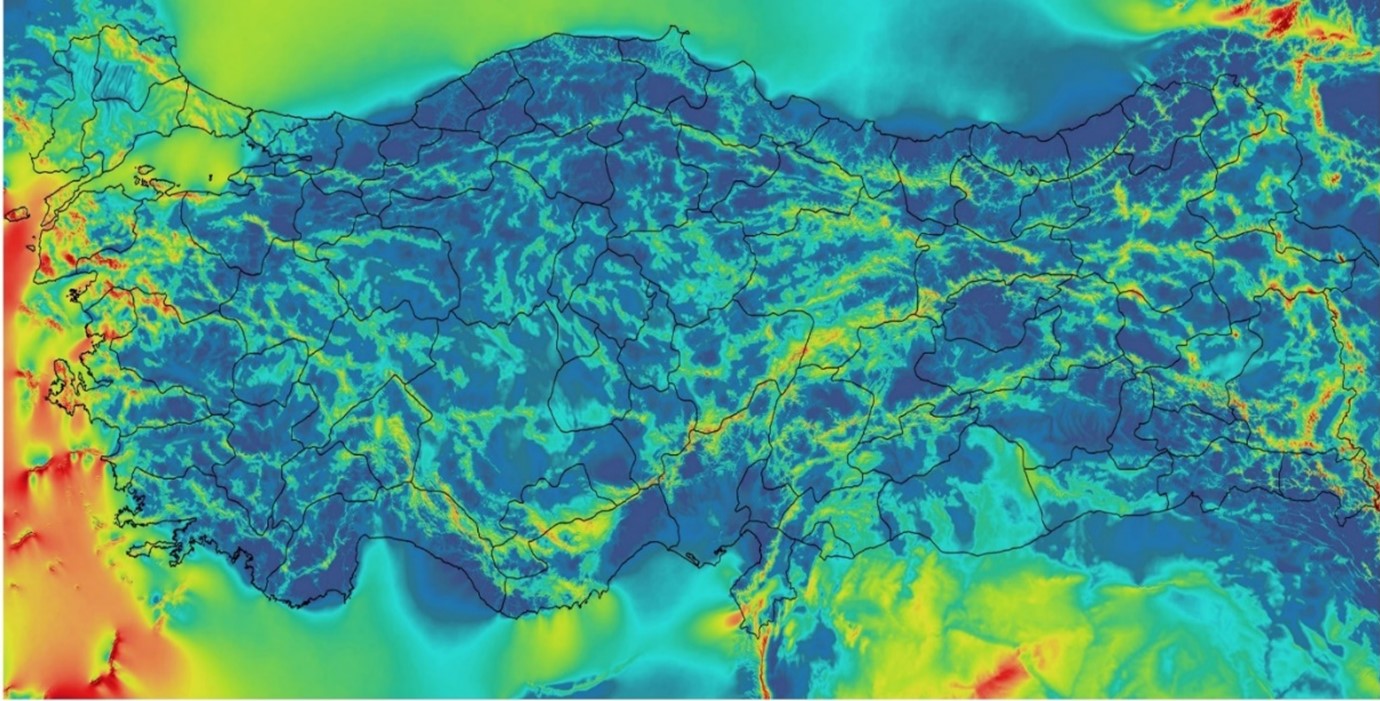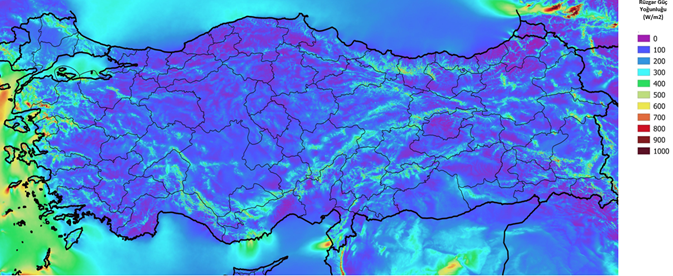Wind

The world, which is experiencing rapid social and economic development, has to produce the required electrical energy in parallel with these developments, in an uninterrupted, high-quality, reliable and economical manner, taking into account environmental impacts. After the oil crisis in 1973, interest in renewable energy sources increased in the world and technologies in this regard were developed rapidly. Although interest in these energy sources decreased with the decrease in oil prices in the 1980s, they came back to the agenda in the 1990s due to increased environmental awareness. Today, the most rapidly developing renewable energy source in terms of use and technology has been wind energy conversion systems. Rapid developments in wind turbine technology, the fact that the costs of electrical energy produced from wind have reached levels that can compete with traditional power plants and that environmental impacts are minimal have enabled wind energy systems to become widespread.
Wind is caused by the differential heating of the earth's surface by solar radiation. The differential heating of the earth's surface causes the temperature, humidity and pressure of the air to change, and this differential pressure causes the air to move. Approximately 2% of the solar energy reaching the earth is converted into wind energy. The characteristics of the wind vary from time to time and regionally, depending on local geographical differences and the non-uniform heating of the earth.
Approximately 2% of the solar energy reaching the earth is converted into wind energy. The characteristics of the wind vary from time to time and regionally, depending on local geographical differences and the non-uniform heating of the earth.
Wind energy is generally used by converting it into two different types of energy. The first of these is the conversion of wind energy into mechanical energy and the other is the conversion of wind energy into electrical energy. The conversion of wind energy into mechanical energy dates back to very old times. It is possible to use the shaft power of the wind turbine in places where mechanical energy is needed, such as pumping water , cutting, mowing, grinding, compressing and oil extraction of various products. The application type with the fastest increasing technology and usage in recent years is the use of wind energy in the production of electrical energy, both for the local production-consumption of electrical energy in rural areas and for the purpose of feeding an interconnected system. Large powerful wind power plants are in the form of wind farms connected to the electrical grid and containing more than one turbine.
Today , the vast majority of wind turbines are installed on land. The fact that commercial wind turbine powers have exceeded MW levels, the high wind potential of the seas and recent developments in installation technologies have also made offshore wind power plant applications widespread.
Wind Energy ?
Wind energy is a natural, renewable, clean and endless power and its source is the sun. A small amount of the energy sent by the sun to the earth , such as 1-2%, is transformed into wind energy. As a result of the sun not heating the earth's surface and atmosphere homogeneously, air currents occur due to the temperature and pressure difference. If an air mass is heated more than its current state, it rises upwards into the atmosphere and a cold air mass of the same volume settles in the space vacated by the rise of this air mass. The displacement of these air masses is called wind. In other words, wind is the air current that occurs due to the pressure differences between two adjacent pressure zones and moves from a high pressure center to a low pressure center. While winds flow from high pressure areas to low pressure areas; they are shaped by reasons such as the rotation of the earth around its own axis, surface friction, local heat dissipation, different atmospheric events in the wind front and the topographic structure of the land. The characteristics of the wind vary temporally and regionally depending on local geographical differences and the non-homogeneous heating of the earth.
Wind Turbine Technology
the main structural elements of wind power plants and are machines that convert the kinetic energy of moving air first into mechanical energy and then into electrical energy. Wind turbines are manufactured as horizontal or vertical axis depending on the direction of their rotation axes. The most commonly used of these types are horizontal axis wind turbines. Horizontal axis wind turbines operate with their rotation axes parallel to the wind direction and their blades perpendicular to the wind direction. These types of wind turbines are manufactured with one, two, three or multiple blades. Horizontal axis wind turbines are called upwind or forward wind turbines when the wind hits the rotor without touching the tower, and downwind or backward wind turbines when it first touches the tower and then hits the rotor . The axes of vertical axis wind turbines are perpendicular and vertical to the wind direction and their blades are also vertical. In vertical axis wind turbines, there is no change of position when the wind blows in a different direction, as in horizontal axis wind turbines . Modern grid-connected wind turbines for electricity generation are mostly 3-bladed, horizontal axis and up-wind type wind turbines.
A wind turbine consists of a body and rotor placed on a tower at a height where the surrounding obstacles will not change the wind speed profile. The blades and hub are called rotors. The rotor is connected to a low-speed main shaft. The kinetic energy of the wind is converted into mechanical energy by the rotor and the rotational motion of the low-speed main shaft is transferred to the transmission system (gearbox or direct drive generator) inside the body, and from there to the generator. The transmission system, generator and auxiliary units are located inside the body. The rotor blades are made of polyester reinforced fiberglass or epoxy reinforced fiber carbon and supported by a composite /steel backbone. The rotor blade diameters of the new generation three-bladed wind turbines have reached 190 m and tower heights of 150 m. In addition to the elements introduced in a wind turbine; there are braking systems, control-command systems, steering engine and mechanism, measurement devices such as anemometer and wind rose.
Parameters and Power Expression Related to Wind Turbines
Air that moves freely in the atmosphere has a certain mass and kinetic energy due to its motion in the form of wind . Based on the principles of conservation of kinetic energy and momentum, the theoretical power of wind P o that moves freely in the atmosphere is given by the mathematical expression below , where ρ is the air density (kg/m3 ) , A is the cross-sectional area perpendicular to the direction of wind advance (m2 ) and V is the wind speed (m/s).
P air = 0.5 ρ V3 A [W]
of the wind is essentially proportional to the cube of the wind speed. Therefore, it is economical to install wind power plants in places where the wind speed is high, and more energy can be produced in such wind resource areas. Po is the part of the theoretical wind power that can be converted into electrical energy by the wind turbine;
P = 0.5 C p rA V3 N G N D NC [W]
Here; C p is the power factor, A is the area swept during rotor rotation (m 2 ), NG is the generator efficiency, ND is the gearbox efficiency and N c is the coupling efficiency. C p is defined as the ratio of the obtained shaft power to the wind power coming to the wind turbine. The power factor is a maximum of 59.3% and this value is called the Betz Limit. For an ideal wind turbine well designed using today's technology, the Cp value is around 40%. CP is a function of the ratio of the rotation speed of the blades (U) to the wind speed impinging on the blades (V) Cp =f(U/V). This (U/V) ratio is also called “Tip- Speed Ratio – lIt is known as “Blade Tip Peripheral Speed Ratio”. As can be understood from this expression, in principle, if the obtained power is desired to be at the maximum level continuously, the rotor rotation speed must be kept at an optimum level that can give the maximum CP value of the blade tip peripheral speed ratio by changing it according to the instantaneous wind speeds in any way. This regulation is carried out automatically in advanced wind turbines.
Wind turbines can only start producing electrical energy at a certain wind speed. Below this wind speed, called “ Cut -in”, the system stops completely. The electrical energy obtained from the system increases with the increase in wind speed. At a certain wind speed for each wind turbine, the power obtained from the system reaches its maximum value. This maximum power is called “nominal power” and this wind speed is called “nominal speed” . If the wind speed exceeds the nominal speed value, the power to be obtained from the system will be as much as the nominal power. In order to prevent damage to the system, wind turbines are automatically stopped after a certain wind speed. This maximum speed is called the “ Cut-out ” speed of the system. In other words, a wind turbine produces energy between the Cut -in and Cut-out wind speeds. The Cut -in speeds of modern wind turbines are between 2-3 m/s, nominal speeds are between 11-15 m/s and Cut-out speeds are between 25-30 m/s.
wind turbine technologies, it is anticipated that Turkey's total wind capacity could reach 140,000-150,000 MW if turbines that can operate efficiently at lower wind speeds, atmospheric temperatures and harsh climate conditions are put into use.
REPA - Turkey Wind Energy Potential
The Turkey Wind Energy Potential Atlas (REPA) has been prepared by the Ministry of Energy and Natural Resources in order to determine the characteristics and distribution of Turkey's wind resources. Using the detailed wind resource maps obtained with the help of this atlas and provided below, it is possible to have an idea about the candidate regions where wind energy plants can be established in Turkey. In order to make an investment decision, preliminary studies including field research should be conducted in the determined region, wind measurements for energy purposes in accordance with the standards, reliable and sufficiently long should definitely be carried out and an investment decision should be made in a way that is supported by the analysis of the measurement data.
Turkey Annual Average Wind Speed Distribution - 100 m.a.g.l.

Turkey Wind Power Density Distribution - 100 m.a.g.l.

According to the Turkey Wind Energy Potential Atlas data;
- It is assessed that if 5.3 MW wind turbines are installed on each square kilometer of all land areas where wind power plants can be installed, with an altitude between 0-3,000 meters and annual average wind speeds at 100 meters above ground level exceeding 6.5 m/s, a total of 57,786 MW of land-based wind power plants can be put into operation.
- If all offshore areas where annual average wind speeds at 100 meters above sea level exceed 7.5 m/s and sea depths between 0 and 200 meters are evaluated with 8.0 MW wind turbines, a total of 20,788 MW of offshore wind power plants can be installed.
Turkey Wind Energy Potential Atlas (REPA) - Wind Energy Resource Information Data Supply
Date of Update: 26 December 2024
Burada yer verilen bilgiler Bakanlığımız Web Sayfası kullanıcılarına bilgi verme amacıyla hazırlanmış olup bağlayıcı bir resmi belge niteliği taşımamaktadır.
Documents & Files


